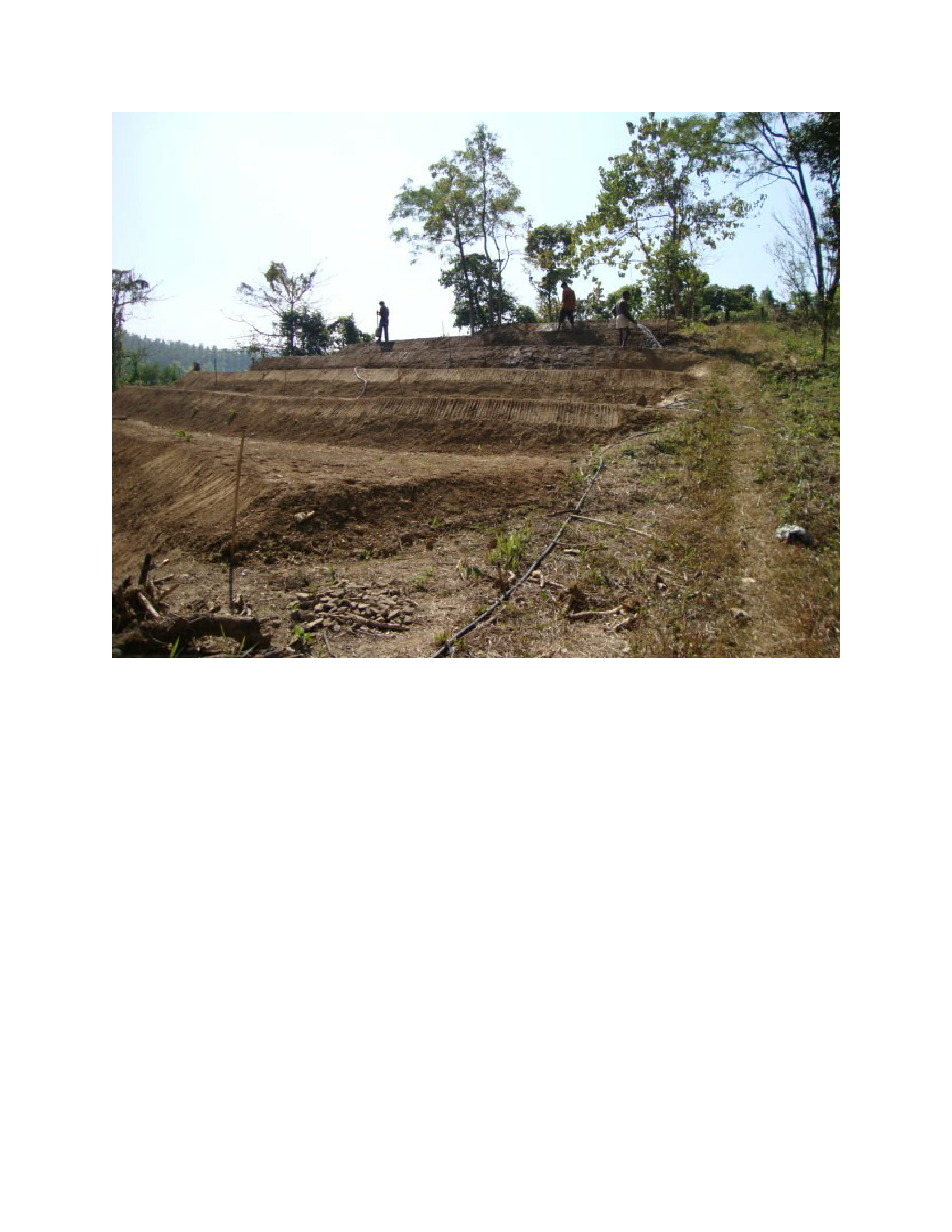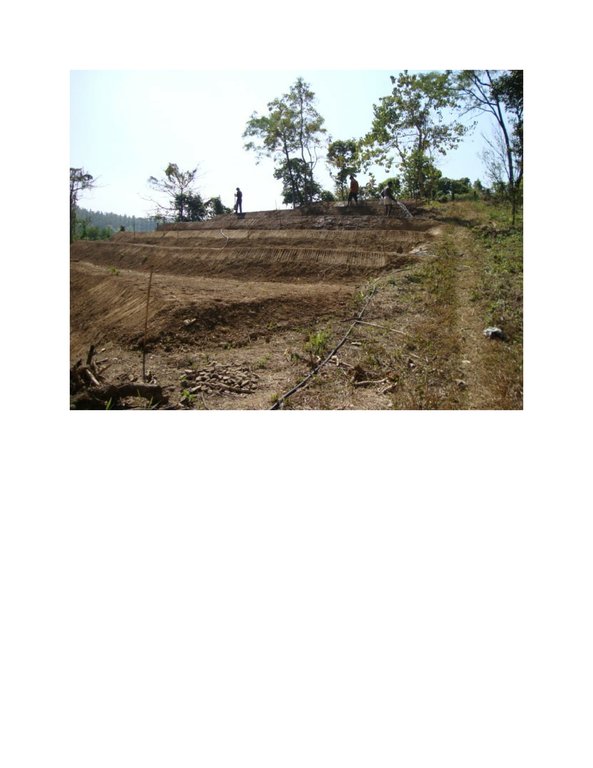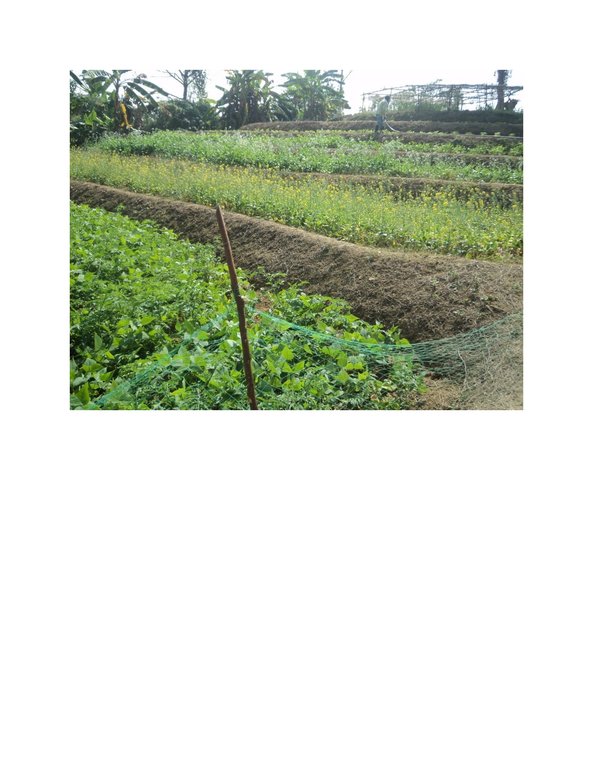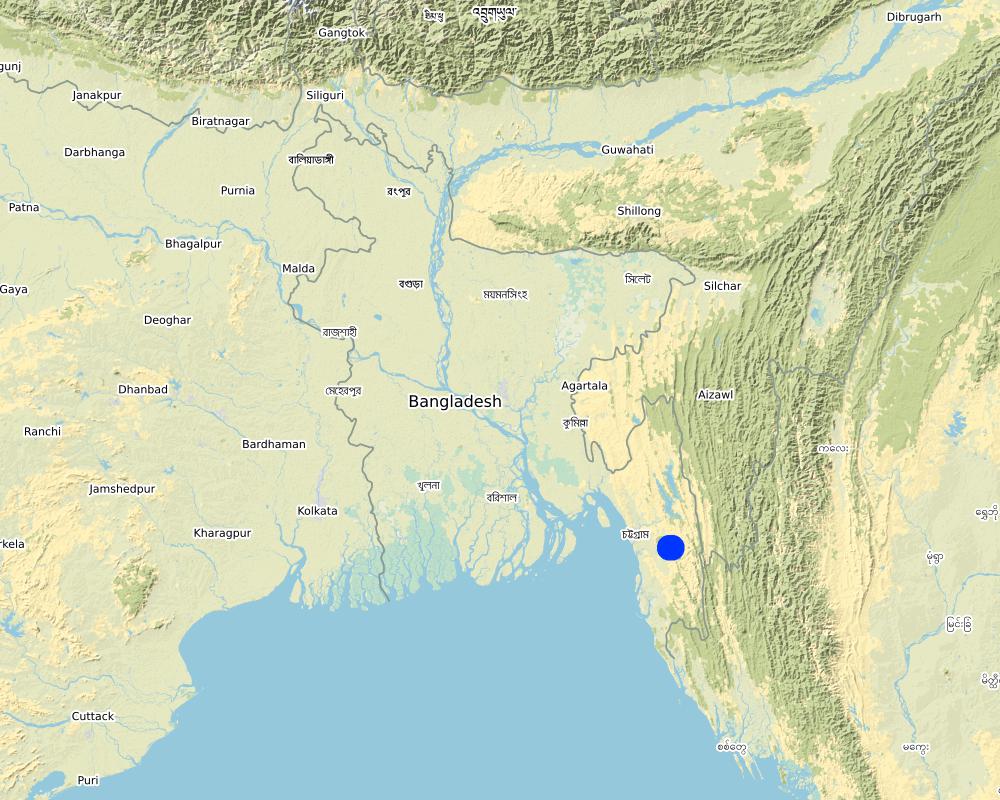Soil Conservation Through Bench Terrace Technology in Highly Degradable Hilly Slopy Areas of Bangladesh [孟加拉国]
- 创建:
- 更新:
- 编制者: Md Babul Hossain
- 编辑者: –
- 审查者: Udo Höggel
"Dhap Poddoti" for soil erosion control in the highly degradable Chattagram Hill tract area of Bangladesh
technologies_4284 - 孟加拉国
查看章节
全部展开 全部收起1. 一般信息
1.2 参与该技术评估和文件编制的资源人员和机构的联系方式
SLM专业人员:
Islam Mahabubul
Soil Resource Development Institute
孟加拉国
土地使用者:
Chakma Ushalaya
Soil Resource Development Institute
孟加拉国
co-compiler:
Md Zahid Ameer
Soil Resource Development Institute
孟加拉国
有助于对技术进行记录/评估的机构名称(如相关)
Soil Resource Development Institute (SRDI) (Soil Resource Development Institute (SRDI)) - 孟加拉国1.3 关于使用通过WOCAT记录的数据的条件
编制者和关键资源人员接受有关使用通过WOCAT记录数据的条件。:
是
1.4 所述技术的可持续性声明
这里所描述的技术在土地退化方面是否存在问题,导致无法被认为是一种可持续的土地管理技术?:
否
注释:
It is a very effective technology for soil conservation in hilly areas.
2. SLM技术的说明
2.1 技术简介
技术定义:
Bench terraces are a soil and water conservation measure used on sloping land with relatively deep soils to retain water and control erosion. They are normally constructed by cutting and filling to produce a series of level steps or benches. This allows water to infiltrate slowly into the soil. Bench terraces are reinforced by banks of soil or stone that block waterflow above the forward edges. This practice is typical for rice-based cropping systems.It is also helpful to increase the beauty of the land along with increasing the soil stability on these lands.
2.2 技术的详细说明
说明:
The Chittagong Hill Tracts (CHT) are undergoing deforestation and land degradation arising from environmentally unsuitable activities such as tobacco cultivation in sloping land, shifting cultivation and logging. Shifting cultivation, also known as slash-and-burn agriculture. The present shifting cultivation system with short fallow in the Chittagong Hill Tracts has accelerated erosion, land degradation, deforestation, and impoverishment of tribal people in CHT. If the present state of degradation continues, most of the areas under shifting cultivation will be severely degraded and future generations will face more difficulties to eke out their livelihoods on further degraded land. That land shows massive erosion impact as influenced by shifting cultivation (Jhum) at steep and continuously sloping lands.
To address the aforesaid constraints in hilly areas of CHT, the Soil Conservation and Watershed Management Centre (SCWMC) of the Soil Resource Development Institute (SRDI) has developed the "Bench Terrace" technology. In this technology, some bench like terraces are made on the slopy land of hills where the slope angle is more than 30 degree. The width of the terraces ranges from 2.5 to 3.0 metre. The height of the terraces is 0.6 metre to 1 metre. An embankment constructed at the outer rim of the terraces prevents run off and soil loss over the outer edge of the terrace during heavy rain in the monsoon. The length of such terraces depends on the topographical contexts within which the terraces are constructed. The technology has various benefits:
- To reduce the quantum of overland flow/sheet flow or runoff, and their velocity.
- To minimize the soil erosion.
- To conserve soil moisture.
- To conserve soil fertility and to facilitate farming operations such as ploughing, irrigation etc. on sloping land.
- To promote intensive land use, permanent agriculture and checking shifting cultivation on steep lands.
- Bench terraces support proper water management and fertilizers/manure application. They will also help in increasing cropping intensity within a stable farming system.
The hill dwellers, who are the owners of the land, are practicing the technology because it has established a permanent solution for crop production instead shifting cultivation. The technology contributes to a reduction in land slides, soil erosion and to increased farm income. Bench Terraces are widely being used in the hilly areas of India, Nepal, Srilanka, Tamilnadu etc.
.
2.3 技术照片
2.5 已应用该技术的、本评估所涵盖的国家/地区/地点
国家:
孟加拉国
区域/州/省:
Bandarban
有关地点的进一步说明:
Its a region
具体说明该技术的分布:
- 均匀地分布在一个区域
如果不知道精确的区域,请注明大致覆盖的区域:
- 10-100 平方千米
技术现场是否位于永久保护区?:
否
注释:
This area is not under reserve forest area of Bangladesh forest department, instead it includes shifting cultivation areas of hill dwellers.
Map
×2.6 实施日期
如果不知道确切的年份,请说明大概的日期:
- 不到10年前(最近)
2.7 技术介绍
详细说明该技术是如何引入的:
- 在实验/研究期间
注释(项目类型等):
Soil conservation and watershed management centre of soil resource development institute(SRDI) has developed the technology through long term research trial in farmers field as well as in research station.
3. SLM技术的分类
3.1 该技术的主要目的
- 改良生产
- 减少、预防、恢复土地退化
- 保护生态系统
- 结合其他技术保护流域/下游区域
- 降低灾害风险
- 创造有益的经济影响
3.2 应用该技术的当前土地利用类型
同一土地单元内混合使用的土地::
否

森林/林地
- (半天然)天然森林/林地
(半天然)天然森林/林地:具体说明管理类型:
- 轮垦
- 非木材森林的利用
以上的树木是落叶树还是常绿树?:
- 混合落叶或常绿
产品和服务:
- 薪材
3.3 由于技术的实施,土地使用是否发生了变化?
由于技术的实施,土地使用是否发生了变化?:
- 是(请在技术实施前填写以下有关土地利用的问题)
同一土地单元内混合使用的土地::
是
具体说明混合土地使用(作物/放牧/树木):
- 农林业

农田
- 一年一作
- 乔木与灌木的种植
年作 - 具体指明作物:
- 蔬菜 - 叶菜(色拉、卷心菜、菠菜和其他)
年作制度:
连作蔬菜
乔木和灌木种植 - 指定作物:
- 柑橘属
采用间作制度了吗?:
否
采用轮作制度了吗?:
否
注释:
The land management and production system contains 3 cropping seasons per annum. The seasons are Rabi- Kharif1-Kharif-2.
3.4 供水
该技术所应用土地的供水:
- 混合雨水灌溉
3.5 该技术所属的SLM组
- 农业林学
- 最小的土壤扰动
- 横坡措施
3.6 包含该技术的可持续土地管理措施

结构措施
- S1:阶地
3.7 该技术强调的主要土地退化类型

土壤水蚀
- Wt:表土流失/地表侵蚀
- Wg:冲沟侵蚀/沟蚀
3.8 防止、减少或恢复土地退化
具体数量名该技术与土地退化有关的目标:
- 减少土地退化
4. 技术规范、实施活动、投入和成本
4.1 该技术的技术图纸
技术规范(与技术图纸相关):
According to the hill slope, the height, width (depth) and length of terrace can vary. Generally the width (depth) of a terrace is 2.5- 3 metre, the height is 1 metre and slope angle 10 to 15 degree. The contour is established by uplifting soil in a straight line and the wall is constructed by mud. The floor area is leveled and cultivated with spade or plough. Generally the floor area of a bench terrace is 40 square metres. An access path is kept open from one corner of the terrace.
The horizontal orientation of the terraces follow the contour line of the slope. That contour line is an imaginary line perpendicular to the sloping direction (uphill to downhill) of an area. The contour line runs horizontally along the slope of a farm.
Viewed from an opposite the face of the slope, all contour lines will appear horizontally. However, viewed from uphill, the lines may either be straight, curved like the outside of a sphere, or curved irregularly downward or upward depending on the presence of low- and high-lying surfaces on the face of the slope.
4.2 有关投入和成本计算的一般信息
具体说明成本和投入是如何计算的:
- 每个技术区域
注明尺寸和面积单位:
1 acre
其它/国家货币(具体说明):
Taka( Bangladeshi currency)
如相关,注明美元与当地货币的汇率(例如1美元=79.9巴西雷亚尔):1美元=:
80.0
注明雇用劳工的每日平均工资成本:
500 taka
4.3 技术建立活动
| 活动 | 时间(季度) | |
|---|---|---|
| 1. | Cleaning forest | Before making the terraces |
| 2. | Earth cutting | Before raining season |
| 3. | Making terraces | |
| 4. | Land preparation | every season |
| 5. | fertiliser application | every season |
| 6. | seed sowing | every season |
| 7. | Irrigation | 5 times per cropping season |
| 8. | Intercultural operation | occassionally |
| 9. | Reconstruction of terraces | Before rainy season |
4.4 技术建立所需要的费用和投入
| 对投入进行具体说明 | 单位 | 数量 | 单位成本 | 每项投入的总成本 | 土地使用者承担的成本% | |
|---|---|---|---|---|---|---|
| 劳动力 | Cleaning forest | persons-per day | 5.0 | 500.0 | 2500.0 | 100.0 |
| 劳动力 | Earth cutting | persons-per day | 4.0 | 500.0 | 2000.0 | 100.0 |
| 劳动力 | Making terraces | persons-per day | 5.0 | 500.0 | 2500.0 | 100.0 |
| 劳动力 | Land preparation | persons-per day | 3.0 | 500.0 | 1500.0 | 100.0 |
| 设备 | fertiliser application | persons-per day | 1.0 | 500.0 | 500.0 | 50.0 |
| 设备 | seed sowing | persons-per day | 2.0 | 500.0 | 1000.0 | 30.0 |
| 设备 | Irrigation | persons-per day | 3.0 | 500.0 | 1500.0 | 70.0 |
| 设备 | Intercultural operation | persons-per day | 4.0 | 500.0 | 2000.0 | 100.0 |
| 设备 | Machine operated cleaning tools | Number | 1.0 | 4000.0 | 4000.0 | 50.0 |
| 设备 | spade | Number | 5.0 | 300.0 | 1500.0 | 100.0 |
| 设备 | mower | Number | 1.0 | 2000.0 | 2000.0 | 100.0 |
| 设备 | sickle | Number | 5.0 | 200.0 | 1000.0 | 100.0 |
| 植物材料 | Tape | Piece | 2.0 | 100.0 | 200.0 | 100.0 |
| 植物材料 | rope | piece | 2.0 | 50.0 | 100.0 | 100.0 |
| 植物材料 | seed | Kg | 0.5 | 300.0 | 150.0 | |
| 植物材料 | seedlings | Number | 50.0 | 50.0 | 2500.0 | |
| 肥料和杀菌剂 | Nitrogen | Kg | 20.0 | 16.0 | 320.0 | 70.0 |
| 肥料和杀菌剂 | Phosphorus | Kg | 10.0 | 22.0 | 220.0 | 70.0 |
| 肥料和杀菌剂 | potassium | Kg | 15.0 | 30.0 | 450.0 | 70.0 |
| 肥料和杀菌剂 | Compost | Ton | 1.0 | 1000.0 | 1000.0 | 100.0 |
| 施工材料 | pesticide | Kg | 0.5 | 200.0 | 100.0 | 50.0 |
| 施工材料 | pipes | Number | 5.0 | 400.0 | 2000.0 | 50.0 |
| 技术建立所需总成本 | 29040.0 | |||||
| 技术建立总成本,美元 | 363.0 | |||||
如果土地使用者负担的费用少于100%,请注明由谁负担其余费用:
Department of Agriculture Extension and other Government and non Government organisation
注释:
The Government organisations always encourage the land owners to practice the technology by giving a portion of inputs.
4.5 维护/经常性活动
| 活动 | 时间/频率 | |
|---|---|---|
| 1. | Reconstruction of terraces | Before rainy season |
4.6 维护/经常性活动所需要的费用和投入(每年)
| 对投入进行具体说明 | 单位 | 数量 | 单位成本 | 每项投入的总成本 | 土地使用者承担的成本% | |
|---|---|---|---|---|---|---|
| 劳动力 | Reconstruction of terraces | Persons-per day | 2.0 | 500.0 | 1000.0 | 80.0 |
| 技术维护所需总成本 | 1000.0 | |||||
| 技术维护总成本,美元 | 12.5 | |||||
4.7 影响成本的最重要因素
描述影响成本的最决定性因素:
Labour cost is the most important factor that affects the total cost.
5. 自然和人文环境
5.1 气候
年降雨量
- < 250毫米
- 251-500毫米
- 501-750毫米
- 751-1,000毫米
- 1,001-1,500毫米
- 1,501-2,000毫米
- 2,001-3,000毫米
- 3,001-4,000毫米
- > 4,000毫米
农业气候带
- 半湿润
Mean annual temperature 27 degree celcius
5.2 地形
平均坡度:
- 水平(0-2%)
- 缓降(3-5%)
- 平缓(6-10%)
- 滚坡(11-15%)
- 崎岖(16-30%)
- 陡峭(31-60%)
- 非常陡峭(>60%)
地形:
- 高原/平原
- 山脊
- 山坡
- 山地斜坡
- 麓坡
- 谷底
垂直分布带:
- 0-100 m a.s.l.
- 101-500 m a.s.l.
- 501-1,000 m a.s.l.
- 1,001-1,500 m a.s.l.
- 1,501-2,000 m a.s.l.
- 2,001-2,500 m a.s.l.
- 2,501-3,000 m a.s.l.
- 3,001-4,000 m a.s.l.
- > 4,000 m a.s.l.
说明该技术是否专门应用于:
- 不相关
5.3 土壤
平均土层深度:
- 非常浅(0-20厘米)
- 浅(21-50厘米)
- 中等深度(51-80厘米)
- 深(81-120厘米)
- 非常深(> 120厘米)
土壤质地(表土):
- 中粒(壤土、粉土)
土壤质地(地表以下> 20厘米):
- 中粒(壤土、粉土)
表土有机质:
- 低(<1%)
如有可能,附上完整的土壤描述或具体说明可用的信息,例如土壤类型、土壤酸碱度、阳离子交换能力、氮、盐度等。:
soils are clay loam to clay, soils are acidic in nature, nitrogen content in most cases low and presence of no salinity. Land type -very high
5.4 水资源可用性和质量
地下水位表:
> 50米
地表水的可用性:
匮乏/没有
水质(未处理):
不良饮用水(需要处理)
水质请参考::
地下水
水的盐度有问题吗?:
否
该区域正在发生洪水吗?:
否
5.5 生物多样性
物种多样性:
- 中等
栖息地多样性:
- 中等
5.6 应用该技术的土地使用者的特征
定栖或游牧:
- 定栖的
生产系统的市场定位:
- 生计(自给)
非农收入:
- 收入的10-50%
相对财富水平:
- 平均水平
个人或集体:
- 个人/家庭
机械化水平:
- 手工作业
性别:
- 女人
土地使用者的年龄:
- 中年人
5.7 应用该技术的土地使用者使用的平均土地面积
- < 0.5 公顷
- 0.5-1 公顷
- 1-2 公顷
- 2-5公顷
- 5-15公顷
- 15-50公顷
- 50-100公顷
- 100-500公顷
- 500-1,000公顷
- 1,000-10,000公顷
- > 10,000公顷
这被认为是小规模、中规模还是大规模的(参照当地实际情况)?:
- 小规模的
5.8 土地所有权、土地使用权和水使用权
土地所有权:
- 个人,未命名
- 个人,有命名
土地使用权:
- 个人
用水权:
- 自由进入(无组织)
土地使用权是否基于传统的法律制度?:
是
5.9 进入服务和基础设施的通道
健康:
- 贫瘠
- 适度的
- 好
教育:
- 贫瘠
- 适度的
- 好
技术援助:
- 贫瘠
- 适度的
- 好
就业(例如非农):
- 贫瘠
- 适度的
- 好
市场:
- 贫瘠
- 适度的
- 好
能源:
- 贫瘠
- 适度的
- 好
道路和交通:
- 贫瘠
- 适度的
- 好
饮用水和卫生设施:
- 贫瘠
- 适度的
- 好
金融服务:
- 贫瘠
- 适度的
- 好
6. 影响和结论性说明
6.1 该技术的现场影响
社会经济效应
生产
作物生产
生产故障风险
生产区域
土地管理
注释/具体说明:
In hilly area , due to slopy land , it is difficult to manage because soil erosion is higher in rainy season, there are no structures to reduce soil erosion. But, due to the establishment of bench terraces, soil erosion in rainy season is significantly checked and long slopy stretches are interupted by a soil stabilising structure. In this way , land management is simplified.
收入和成本
农业投入费用
农业收入
收入来源的多样性
经济差异
工作量
社会文化影响
食品安全/自给自足
健康状况
土地使用权/用水权
文化机会
娱乐机会
注释/具体说明:
As the economic situation is improved through increased crop production due to this method, the land owners will beneift from new opportunities for recreational programmes.
社区机构
国家机构
SLM/土地退化知识
冲突缓解
社会经济弱势群体的情况
生态影响
土壤
土壤水分
土壤覆盖层
土壤流失
土壤堆积
养分循环/补给
土壤有机物/地下C
酸度
注释/具体说明:
As the land owners use balanced fertiliser , with proper irrigation and other intercultural operations, so, soil acidity will reduce a little bit.
生物多样性:植被、动物
植被覆盖
生物量/地上C
植物多样性
动物多样性
注释/具体说明:
As planned cropping system is going to be established in bench terrace land management system, so soil flora and fauna will get a suitable environment to grow.
有益物种
栖息地多样性
害虫/疾病控制
减少气候和灾害风险
滑坡/泥石流
干旱影响
碳和温室气体的排放
注释/具体说明:
In this production system, cropping intensity is increased 2-3 times and the crops are absorbing more CO2 for photosynthesis. So, carbon emission will reduce.
火灾风险
微气候
6.2 该技术的场外影响已经显现
下游淤积
对邻近农田的破坏
对公共/私人基础设施的破坏
温室气体的影响
注释/具体说明:
In this production system, cropping intensity is increased 2-3 times and the crops are absorbing more co2 for photosynthesis. So, carbon emission will reduce.
6.3 技术对渐变气候以及与气候相关的极端情况/灾害的暴露和敏感性(土地使用者认为的极端情况/灾害)
渐变气候
渐变气候
| 季节 | 增加或减少 | 该技术是如何应对的? | |
|---|---|---|---|
| 年温度 | 增加 | 适度 | |
| 季节性温度 | 夏季 | 增加 | 好 |
| 年降雨量 | 增加 | 适度 | |
| 季雨量 | 湿季/雨季 | 减少 | 适度 |
气候有关的极端情况(灾害)
气象灾害
| 该技术是如何应对的? | |
|---|---|
| 热带风暴 | 适度 |
| 局地暴雨 | 好 |
| 局地雷暴 | 适度 |
| 局地雹灾 | 非常好 |
| 局地风暴 | 适度 |
气候灾害
| 该技术是如何应对的? | |
|---|---|
| 干旱 | 适度 |
| 森林火灾 | 适度 |
| 陆地火灾 | 好 |
水文灾害
| 该技术是如何应对的? | |
|---|---|
| 滑坡 | 非常好 |
生物灾害
| 该技术是如何应对的? | |
|---|---|
| 昆虫/蠕虫侵扰 | 好 |
6.4 成本效益分析
技术收益与技术建立成本相比如何(从土地使用者的角度看)?
短期回报:
积极
长期回报:
非常积极
技术收益与技术维护成本/经常性成本相比如何(从土地使用者的角度看)?
短期回报:
非常积极
长期回报:
非常积极
6.5 技术采用
- > 50%
在所有采用这项技术的人当中,有多少人是自发的,即未获得任何物质奖励/付款?:
- 11-50%
6.6 适应
最近是否对该技术进行了修改以适应不断变化的条件?:
否
6.7 该技术的优点/长处/机会
| 土地使用者眼中的长处/优势/机会 |
|---|
| Risk of land slide reduced |
| Farm income increased |
| 编制者或其他关键资源人员认为的长处/优势/机会 |
|---|
| Soil erosion decreased |
| Crop production increased |
| Soil nutrient mining reduced |
| Soil nutrient availability enhanced |
| Soil moisture increased |
| Irrigation water use efficiency increased |
6.8 技术的弱点/缺点/风险及其克服方法
| 土地使用者认为的弱点/缺点/风险 | 如何克服它们? |
|---|---|
| Labour cost very high | Borrow money from financial institution |
| 编制者或其他关键资源人员认为的弱点/缺点/风险 | 如何克服它们? |
|---|---|
| Lack of knowledge regarding land management in slopy hilly areas | Take part in related training |
| Labour unavailability and labour cost is higher | Engaged family members |
7. 参考和链接
7.1 信息的方法/来源
- 实地考察、实地调查
10
- 与SLM专业人员/专家的访谈
10
- 根据报告和其他现有文档进行编译
5
(现场)数据是什么时候汇编的?:
16/04/2018
7.2 参考可用出版物
标题、作者、年份、ISBN:
Soil erosion in hilly areas affecting biodiversity and climate change and its biological conservation strategy,Md. Mijanur Rahman Wildlife Conservation Officer Coastal & Wetland Biodiversity Management Project Department of Environment, Teknaf, Cox’s Bazar
可以从哪里获得?成本如何?
FAO, 1978. Soil erosion by water. FAO, United Nations. PP. 63-111 Khan, L.R. Watershed management. Field document no.44. UNDP/FAO/BGD/85/011. PP.151-193 Negi, S.S. 1983. Soil conservation. Fundamental of forestry volume.3. Rahman, M.M. 1994. A review paper on erosion control measures in hilly areas. FWT discipline, Khulna University, Khulna, Bangladesh Young, Anthony. 1989. Agro forestry for soil conservation. ICRAF.
标题、作者、年份、ISBN:
Soil erosion in the Chittagong hill tract and its impact on nutrient status of soils [in Bangladesh] [1992],Farid, A.T.M. Iqbal, A. Karim, Z.
可以从哪里获得?成本如何?
AGRIS, FAO
7.3 链接到网络上的相关信息
标题/说明:
A review of the effect of terracing on erosion,
URL:
https://www.researchgate.net/profile/Luuk_Dorren
7.4 一般注释
The questionnaire should be more generalised so that all the land degradation specialists can fill up the document smoothly.
链接和模块
全部展开 全部收起链接
无链接
模块
无模块







